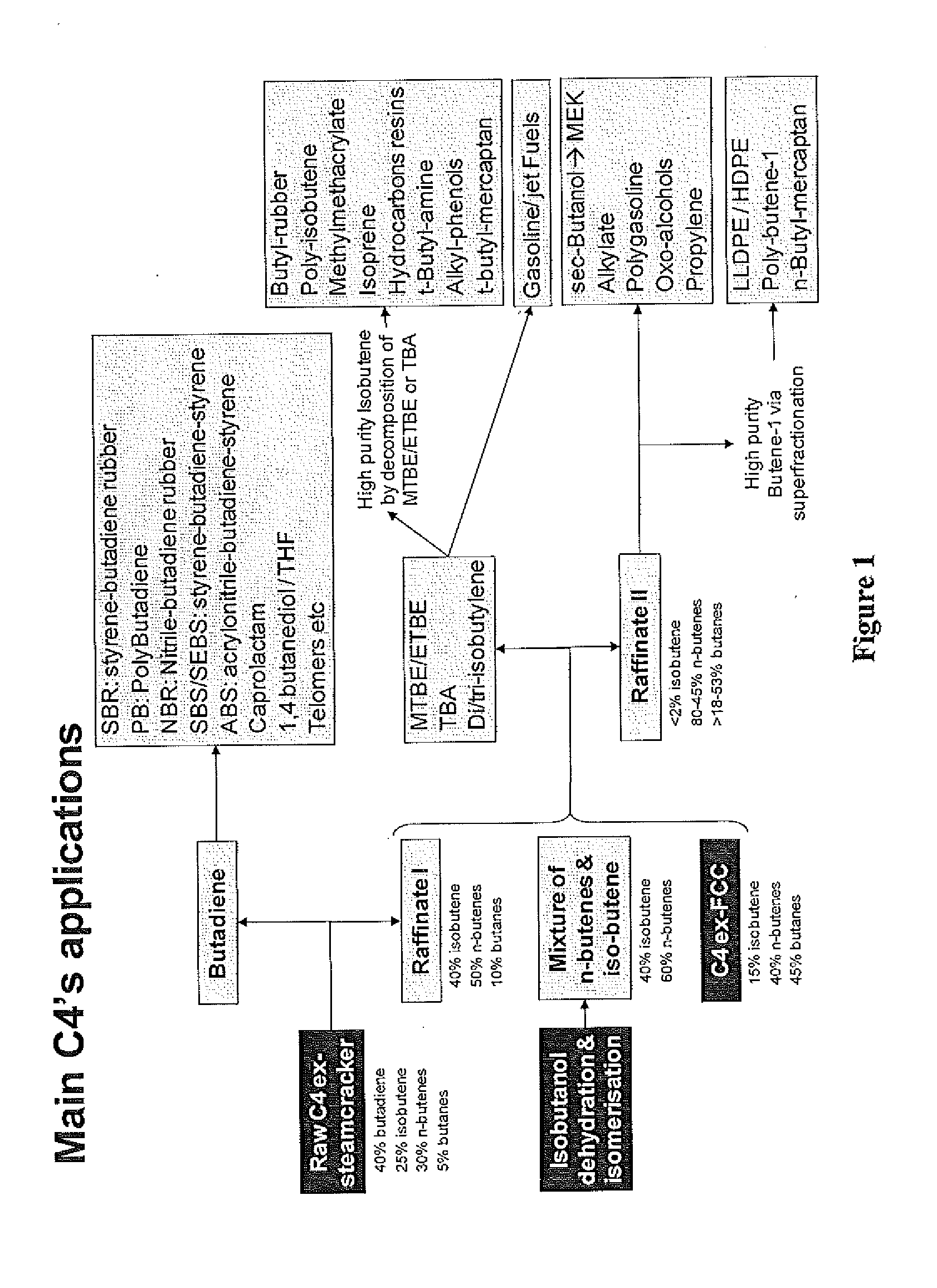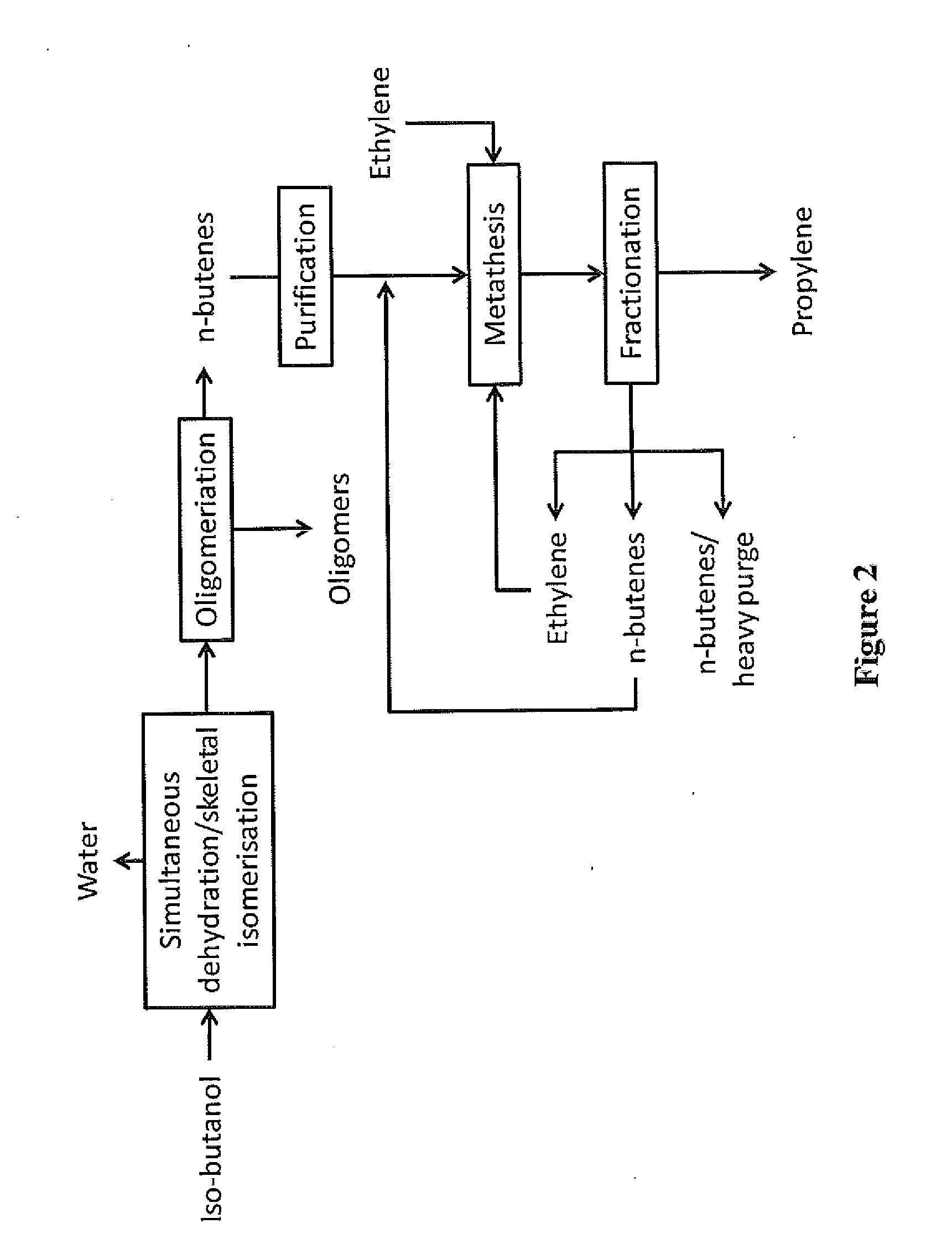Production of propylene via simultaneous dehydration and skeletal isomerisation of isobutanol on acid catalysts followed by metathesis
a technology of isobutanol and propylene, which is applied in the direction of hydrocarbon by metathesis reaction, hydrocarbon preparation catalyst, bulk chemical production, etc., can solve the problem of reducing the selectivity of desired products, reducing the and high secondary reaction (substitution or addition) rate, so as to achieve the effect of reducing capital investment and high yield of total butenes
- Summary
- Abstract
- Description
- Claims
- Application Information
AI Technical Summary
Benefits of technology
Problems solved by technology
Method used
Image
Examples
example 1
According to the Invention
[0125]The catalyst used here is a crystalline silicate of the FER structure. The H-FER has a Si / Al of 33 under powder form. The catalyst is calcinated with air at 550° C. during 4 hours before formulation in pellets of 35-45 mesh.
[0126]An isobutanol / water mixture having the 95 / 5 wt % composition has been processed on the catalyst under 2 bara, at temperatures between 350 and 375° C., and with an isobutanol space velocity from 7 to 21 h−1.
[0127]In this set of operating conditions, isobutanol conversion is almost complete, with a butenes selectivity of over 95% wt, and an iso-butene selectivity of around 41-43%. Low amounts of C4+ compounds are formed.
FEEDiButOH / H2O (95 / 5)% wtP (bara)22222T (° C.)350.0350.0350.0375.0375.0WHSV (H-1)7.312.621.021.012.6conversion (% wt CH2)100.099.489.799.899.2Oxygenates on C-basis (% wt CH2) - averageEther0.00.00.00.00.0Other alcohol0.10.10.20.10.1Aldehyde + Ketone0.10.10.10.10.1Yield on C-basis (% wt CH2) - averageParaffins1.0...
example 3
According to the Invention
[0130]The catalyst is a phosphorous modified zeolite (P-ZSM5), prepared according to the following recipe. A sample of zeolite ZSM-5 (Si / Al=13) in H-form was steamed at 550° C. for 6 h in 100% H2O. The steamed solid was subjected to a contact with an aqueous solution of H3PO4 (85% wt) for 2 h under reflux condition (4 ml / 1 g zeolite). Then 69.9 g of CaCO3 was introduced by maintaining a pH of 2.52. Then the solution was dried by evaporation for 3 days at 80° C. 750 g of the dried sample was extruded with 401.5 g of Bindzil and 0.01 wt % of extrusion additives. The extruded solid was dried at 110° C. for 16 h and calcinated at 600° C. for 10 h.
[0131]An isobutanol / water mixture having the 95 / 5 wt % composition has been processed on the catalyst under 1.5 bara, at temperatures between 280 and 350° C., and with an isobutanol space velocity of about 7 h−1.
[0132]In this set of operating conditions, isobutanol conversion is almost complete, with a butenes selectiv...
PUM
| Property | Measurement | Unit |
|---|---|---|
| Temperature | aaaaa | aaaaa |
| Temperature | aaaaa | aaaaa |
| Temperature | aaaaa | aaaaa |
Abstract
Description
Claims
Application Information
 Login to View More
Login to View More - R&D
- Intellectual Property
- Life Sciences
- Materials
- Tech Scout
- Unparalleled Data Quality
- Higher Quality Content
- 60% Fewer Hallucinations
Browse by: Latest US Patents, China's latest patents, Technical Efficacy Thesaurus, Application Domain, Technology Topic, Popular Technical Reports.
© 2025 PatSnap. All rights reserved.Legal|Privacy policy|Modern Slavery Act Transparency Statement|Sitemap|About US| Contact US: help@patsnap.com



